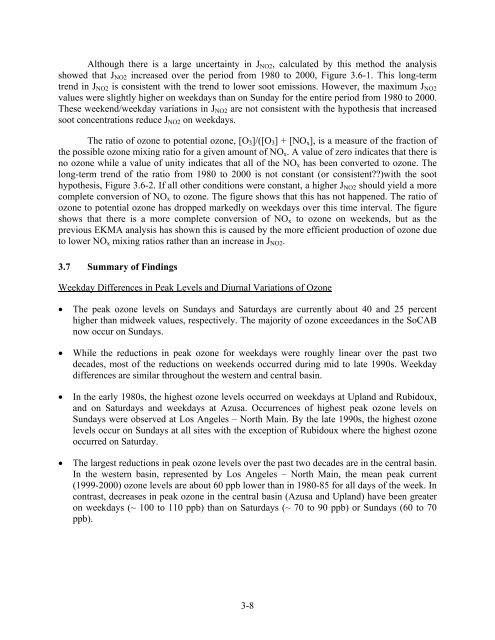Weekend/Weekday Ozone Observations in the South Coast Air Basin
Weekend/Weekday Ozone Observations in the South Coast Air Basin
Weekend/Weekday Ozone Observations in the South Coast Air Basin
You also want an ePaper? Increase the reach of your titles
YUMPU automatically turns print PDFs into web optimized ePapers that Google loves.
Although <strong>the</strong>re is a large uncerta<strong>in</strong>ty <strong>in</strong> J NO2 , calculated by this method <strong>the</strong> analysis<br />
showed that J NO2 <strong>in</strong>creased over <strong>the</strong> period from 1980 to 2000, Figure 3.6-1. This long-term<br />
trend <strong>in</strong> J NO2 is consistent with <strong>the</strong> trend to lower soot emissions. However, <strong>the</strong> maximum J NO2<br />
values were slightly higher on weekdays than on Sunday for <strong>the</strong> entire period from 1980 to 2000.<br />
These weekend/weekday variations <strong>in</strong> J NO2 are not consistent with <strong>the</strong> hypo<strong>the</strong>sis that <strong>in</strong>creased<br />
soot concentrations reduce J NO2 on weekdays.<br />
The ratio of ozone to potential ozone, [O 3 ]/([O 3 ] + [NO x ], is a measure of <strong>the</strong> fraction of<br />
<strong>the</strong> possible ozone mix<strong>in</strong>g ratio for a given amount of NO x . A value of zero <strong>in</strong>dicates that <strong>the</strong>re is<br />
no ozone while a value of unity <strong>in</strong>dicates that all of <strong>the</strong> NO x has been converted to ozone. The<br />
long-term trend of <strong>the</strong> ratio from 1980 to 2000 is not constant (or consistent??)with <strong>the</strong> soot<br />
hypo<strong>the</strong>sis, Figure 3.6-2. If all o<strong>the</strong>r conditions were constant, a higher J NO2 should yield a more<br />
complete conversion of NO x to ozone. The figure shows that this has not happened. The ratio of<br />
ozone to potential ozone has dropped markedly on weekdays over this time <strong>in</strong>terval. The figure<br />
shows that <strong>the</strong>re is a more complete conversion of NO x to ozone on weekends, but as <strong>the</strong><br />
previous EKMA analysis has shown this is caused by <strong>the</strong> more efficient production of ozone due<br />
to lower NO x mix<strong>in</strong>g ratios ra<strong>the</strong>r than an <strong>in</strong>crease <strong>in</strong> J NO2 .<br />
3.7 Summary of F<strong>in</strong>d<strong>in</strong>gs<br />
<strong>Weekday</strong> Differences <strong>in</strong> Peak Levels and Diurnal Variations of <strong>Ozone</strong><br />
• The peak ozone levels on Sundays and Saturdays are currently about 40 and 25 percent<br />
higher than midweek values, respectively. The majority of ozone exceedances <strong>in</strong> <strong>the</strong> SoCAB<br />
now occur on Sundays.<br />
• While <strong>the</strong> reductions <strong>in</strong> peak ozone for weekdays were roughly l<strong>in</strong>ear over <strong>the</strong> past two<br />
decades, most of <strong>the</strong> reductions on weekends occurred dur<strong>in</strong>g mid to late 1990s. <strong>Weekday</strong><br />
differences are similar throughout <strong>the</strong> western and central bas<strong>in</strong>.<br />
• In <strong>the</strong> early 1980s, <strong>the</strong> highest ozone levels occurred on weekdays at Upland and Rubidoux,<br />
and on Saturdays and weekdays at Azusa. Occurrences of highest peak ozone levels on<br />
Sundays were observed at Los Angeles – North Ma<strong>in</strong>. By <strong>the</strong> late 1990s, <strong>the</strong> highest ozone<br />
levels occur on Sundays at all sites with <strong>the</strong> exception of Rubidoux where <strong>the</strong> highest ozone<br />
occurred on Saturday.<br />
• The largest reductions <strong>in</strong> peak ozone levels over <strong>the</strong> past two decades are <strong>in</strong> <strong>the</strong> central bas<strong>in</strong>.<br />
In <strong>the</strong> western bas<strong>in</strong>, represented by Los Angeles – North Ma<strong>in</strong>, <strong>the</strong> mean peak current<br />
(1999-2000) ozone levels are about 60 ppb lower than <strong>in</strong> 1980-85 for all days of <strong>the</strong> week. In<br />
contrast, decreases <strong>in</strong> peak ozone <strong>in</strong> <strong>the</strong> central bas<strong>in</strong> (Azusa and Upland) have been greater<br />
on weekdays (~ 100 to 110 ppb) than on Saturdays (~ 70 to 90 ppb) or Sundays (60 to 70<br />
ppb).<br />
3-8
















